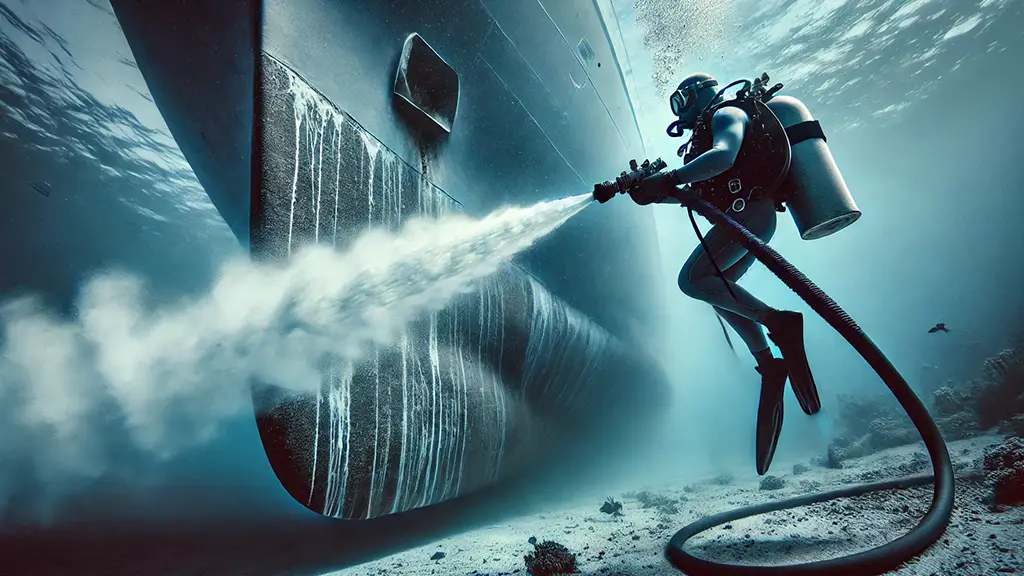Introduction
Maintaining the hull of a ship is crucial for optimal performance, fuel efficiency, and longevity. Traditional hull cleaning methods, though widely used, have several drawbacks, including environmental damage and high costs. This article explores why you should forget traditional methods and embrace innovative alternatives for ship hull cleaning.
What is Ship Hull Cleaning?
Ship hull cleaning involves the removal of marine fouling and debris from the underwater portion of a ship’s hull. This process is essential for maintaining a vessel’s performance, reducing drag, improving fuel efficiency, and prolonging the lifespan of the hull.
Traditional Ship Hull Cleaning Methods
Traditional methods of hull cleaning include:
- Scrubbing: Manual cleaning with brushes and scrapers.
- Blasting: Using high-pressure water or abrasive materials to remove fouling.
- Dry-Docking: Removing the ship from the water to clean the hull.
Drawbacks of Traditional Methods
Environmental Impact: Traditional cleaning methods often release harmful substances into the water, affecting marine life and ecosystems.
Cost: The expenses involved in dry-docking and using abrasive materials can be significant.
Time Consumption: Traditional methods are labor-intensive and time-consuming, leading to longer downtime for ships.
Inefficiency: Manual and abrasive cleaning methods may not effectively remove all fouling, leading to frequent cleaning needs.
Innovative Hull Cleaning Technologies
Robotic Hull Cleaning
Robotic systems have revolutionized hull cleaning by providing efficient, precise, and environmentally friendly solutions. These systems use advanced sensors and software to navigate and clean the hull, significantly reducing human labor and environmental impact.
Hydroblasting
Hydroblasting involves using high-pressure water jets to clean the hull. This method is highly effective in removing tough fouling without the use of harmful chemicals or abrasive materials.
Ultrasonic Hull Cleaning
Ultrasonic cleaning employs high-frequency sound waves to create cavitation bubbles that dislodge fouling from the hull surface. This non-invasive method is gentle on the hull and highly effective in preventing biofouling.
Chemical Cleaning Alternatives
Eco-friendly chemicals are now available that offer effective hull cleaning without the negative environmental impact of traditional chemicals. These alternatives are biodegradable and safe for marine life.
Economic Benefits of Modern Methods
Modern hull cleaning methods offer significant cost savings through reduced labor, decreased downtime, and improved fuel efficiency. The return on investment for these technologies can be substantial, making them an attractive option for ship owners and operators.
Environmental Impact
Innovative cleaning methods minimize environmental impact by reducing the release of harmful substances into the water and preventing the spread of invasive species. These methods help protect marine ecosystems and comply with environmental regulations.
Case Studies of Successful Implementations
Several shipping companies have successfully implemented modern hull cleaning technologies, achieving significant cost savings and environmental benefits. For example, Maersk has adopted robotic hull cleaning systems across its fleet, resulting in improved fuel efficiency and reduced maintenance costs.
Regulations and Compliance
Maritime regulations increasingly emphasize environmental protection and sustainability. Modern hull cleaning methods help ships comply with these regulations, ensuring that they meet international standards for pollution control and biosecurity.
Technological Advances in Hull Cleaning
Recent advancements in hull cleaning technology include the development of autonomous underwater vehicles (AUVs) and artificial intelligence (AI) systems that enhance the efficiency and effectiveness of hull cleaning operations.
Choosing the Right Method for Your Ship
When selecting a hull cleaning method, consider factors such as the size and type of vessel, the extent of fouling, environmental regulations, and budget. Consulting with experts and evaluating the specific needs of your ship can help in making an informed decision.
DIY vs. Professional Hull Cleaning
While DIY hull cleaning can be cost-effective, it often lacks the precision and efficiency of professional services. Hiring professionals ensures thorough cleaning, compliance with regulations, and the use of advanced technologies.
Maintenance Tips Post-Cleaning
After cleaning the hull, regular maintenance is essential to prevent rapid re-fouling. Applying antifouling coatings, conducting periodic inspections, and using in-water cleaning technologies can help maintain a clean hull.
Cost Analysis of Different Methods
Comparing the costs of traditional and modern hull cleaning methods reveals that, despite higher initial investments, modern technologies offer long-term savings through reduced labor costs, lower fuel consumption, and decreased environmental fines.
Safety Considerations
Safety is paramount during hull cleaning operations. Ensure that all personnel are trained in the use of cleaning equipment and adhere to safety protocols to prevent accidents and injuries.
Innovative Hull Cleaning Equipment
Modern hull cleaning equipment includes robotic cleaners, hydroblasting systems, and ultrasonic devices. These tools are designed for efficiency, safety, and minimal environmental impact.
Training and Skills Required
Operating advanced hull cleaning technologies requires specialized training and skills. Personnel must be proficient in using robotic systems, high-pressure equipment, and chemical solutions to ensure effective and safe cleaning.
FAQs
What is the best method for ship hull cleaning?
The best method depends on the specific needs of your vessel, including size, fouling extent, and environmental considerations. Robotic and ultrasonic cleaning are popular modern options.
How often should a ship hull be cleaned?
Hull cleaning frequency varies, but it’s generally recommended every six months to a year, depending on the vessel’s usage and operating conditions.
Are modern hull cleaning methods environmentally friendly?
Yes, modern methods like robotic cleaning and hydroblasting are designed to be eco-friendly, minimizing pollution and protecting marine life.
Is robotic hull cleaning expensive?
While the initial investment may be higher, robotic hull cleaning offers long-term cost savings through reduced labor, downtime, and improved fuel efficiency.
Can ultrasonic cleaning damage the hull?
No, ultrasonic cleaning is gentle and non-invasive, making it safe for various hull materials without causing damage.
What regulations must be followed for hull cleaning?
Regulations vary by region, but generally include guidelines for pollution control, biosecurity, and the use of eco-friendly cleaning methods.
Conclusion
Forgetting traditional hull cleaning methods in favor of modern technologies can lead to improved efficiency, reduced costs, and better environmental outcomes. Embracing innovations like robotic cleaning, hydroblasting, and ultrasonic cleaning ensures that your ship operates at peak performance while complying with regulations and protecting the marine environment.



